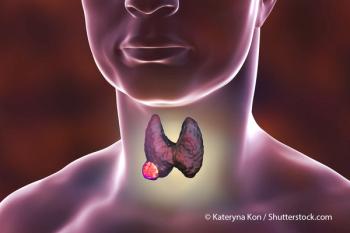Patient age was found to be significantly associated with mortality from papillary thyroid cancer (PTC) in a linear fashion with no apparent age cut point, according to the results of a study published in the Journal of Clinical Oncology.
“Despite the widely accepted concept that dichotomizing patient age around a cut point of 45 years is an important prognostic indicator in PTC, the current study demonstrates that patient age is significantly associated with an increased risk of disease-specific mortality in a continuous, linear fashion, without an apparent age cut point demarcating survival difference,” wrote researcher Mohamed Abdelgadir Adam, of Duke University Medical Center, and colleagues. “These results challenge the appropriateness of using a patient age cut point in current staging systems for PTC and suggest that current staging systems well might understage young patients (< 45 years) with intermediate and high-risk tumors.”
According to the study, age is known to have a prognostic role in PTC, and is included as part of the American Joint Committee on Cancer staging system, with a distinct cut point at age 45 years.
“The majority of thyroid cancer staging systems have incorporated patient age treated as a dichotomous variable into risk stratification as a formal consideration.” the researchers explained.
In this study, Adam and colleague wanted to further explore the relationship between patient age at diagnosis and cancer-specific survival in patients with PTC, hypothesizing that age was linearly associated with worse survival without any cut point. They looked at data from 31,802 patients with PTC who underwent surgery from the SEER database from 1998 to 2012.
“In our study, we examined the adjusted association between patient age and survival using a multivariable regression model incorporating restricted cubic splines,” the researchers wrote. “The restricted cubic splines function permitted us to explore the relationship between patient age and cancer-specific mortality without the need for any prespecified assumption about this relationship.”
10-Year Cancer-Specific Survival
The researchers calculated the following 10-year cancer-specific survivals, which were inversely associated with increasing patient age:
2 to 19: 99.8%;
20 to 29: 99.9%;
30 to 39:99.8%;
40 to 49: 99.5%;
50 to 59: 98.1%;
60 to 69: 94.8%;
70 to 79: 91.5%;
80 to 89: 79.2%;
90-plus: 73.9%.
The median age of patients was 45. The median follow-up was 59 months during which there were 331 cancer-related deaths.
“There seems to be no patient age cut point corresponding to a marked decrement in survival, challenging the appropriateness of a patient age cut point in current staging systems for PTC,” the researchers wrote.
Patient age was significantly associated with increasing mortality even after adjusting for patient demographics, and clinical and treatment characteristics (P < .001).
“Our results strongly challenge the appropriateness of the widely accepted treatment of age as a dichotomous factor in the staging for PTC,” the researchers wrote. “The concept of an age cut point has been propagated for decades on the basis of data from the mid-1900s, which demonstrated a sharp rise in mortality from thyroid cancer among patients older than 45 years. However, it is important to highlight that these studies are old, are based on a small number of patients, and lacked adjustment for important competing factors. Therefore, it would seem important to reassess the accuracy of current staging systems for PTC, most of which incorporate a patient age cut point of 45 years.”
















































































